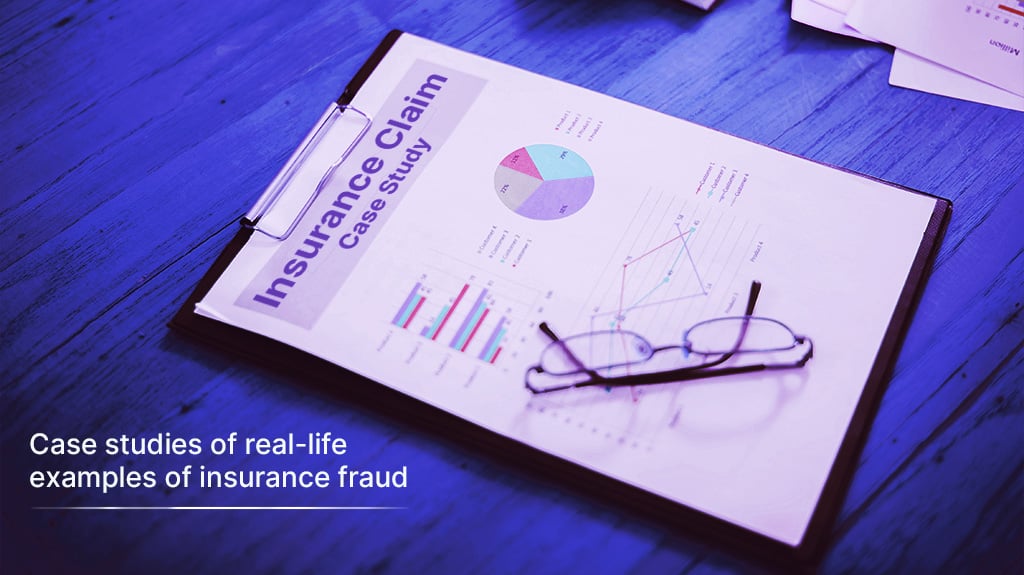Insurance fraud is a pervasive issue that affects both insurers and policyholders alike. From faked accidents to inflated claims, fraudsters employ various tactics to deceive the system and reap undeserved benefits. Therefore, recognizing the red flags of insurance fraud is crucial for individuals and insurance companies to protect themselves.
This blog will explore the different types of insurance fraud and highlight the warning signs that can help identify fraudulent activities. By understanding these red flags, we can all contribute to combating insurance fraud and fostering a more transparent and trustworthy insurance industry.
Different Types of Insurance Fraud
Insurance fraud can manifest in various ways, each requiring vigilance and effective preventive measures. Identifying the diverse forms of insurance fraud is crucial for insurers and consumers to protect themselves from scams. Here are some additional lines exploring other types of insurance fraud:
Auto Insurance Fraud
This fraud involves individuals trying to trick an insurance company regarding a claim related to their personal or commercial motor vehicle. It encompasses various deceptive tactics such as providing misleading information or submitting forged documents to bolster their claim.
The majority of arrests related to automotive insurance fraud typically revolve around the following activities:
- Orchestrating staged auto accidents and making false injury claims.
- Filing false reports of stolen vehicles.
- Making claims for accidents that allegedly occurred after purchasing a policy or coverage.
- Submitting false claims for pre-existing damages.
Healthcare Fraud
This fraud involves submitting false or deceptive information to a health insurance company to illicitly obtain unauthorized benefits for the policyholder, another party, or the service provider. The insured individual and the healthcare service provider can be responsible for committing this offense.
Individual subscribers may engage in health insurance fraud by:
- Allowing someone else to use their identity and insurance information to access healthcare services.
- Using insurance benefits to cover prescriptions that their doctor did not prescribe.
Healthcare providers can commit fraudulent acts by:
- Billing for services, procedures, or supplies that were never actually provided.
- Charging for more expensive services than those that were rendered.
- Performing unnecessary services solely for financial gain.
- Misrepresenting non-covered treatments as medically necessary.
- Falsifying a patient's diagnosis to justify tests, surgeries, or other procedures.
- Billing each step of a single procedure as separate procedures.
- Overcharging patients beyond the agreed co-pay under the insurer's terms.
- Offering or receiving "kickbacks" in exchange for referring motor vehicle accident victims for treatment.
Workers' Compensation Fraud
Similar to other types of insurance fraud, workers' compensation insurance can be compromised when employers or employees provide false or misleading information to insurance companies.
Individuals commonly commit insurance fraud in the following ways:
- Faking an injury at work to receive paid time off.
- Exaggerating the severity of a genuine injury to obtain additional time off or benefits.
- Claiming an injury occurred on the job when it happened elsewhere.
- Taking a new job and deceiving the insurance company about the inability to return to the previous place of employment or concealing income from another job.
Employers can commit insurance fraud through the following actions:
- Understating the company's payroll amount to lower premium payments.
- Wrongfully classifying employees as independent contractors.
- Providing false information about employees' job duties to qualify for lower premium payments.
All these types of insurance fraud constitute a severe criminal offense, with potential consequences including imprisonment of up to seven years and fines reaching a maximum of $15,000. In addition, individuals involved in such fraudulent activities may face additional financial burdens such as court costs and legal fees. Moreover, being convicted of insurance fraud carries lifelong repercussions, including the social stigma and limitations of being a felon.
Red Flags to Look Out for When Detecting Insurance Fraud
Detecting insurance fraud requires a keen eye and attention to detail. However, several red flags and warning signs can help insurance companies, and consumers identify potentially fraudulent activities. Here are some key red flags to look out for when detecting insurance fraud:
Inconsistent or Suspicious Claims
Pay attention to claims that contain inconsistencies, such as contradicting statements or medical records that don't align with reported injuries. Also, look for overly complex claims that involve excessive medical treatments or show a sudden increase in the frequency of claims from the same policyholder.
Prior Loss History
Review the claimant's previous insurance history. Individuals with frequent claims or a history of suspicious or denied claims may indicate a higher likelihood of insurance fraud.
Recent Policy Purchase
Be wary of policyholders who have recently purchased an insurance policy and then quickly filed a claim. This could suggest the intent to defraud the insurer by purchasing coverage to make a fraudulent claim.

Unusual Circumstances
Pay attention to claims filed immediately after a new policy takes effect or shortly before the policy is due to expire. Also, be cautious when multiple claims are filed from the same accident or event by different policyholders or when the loss coincides with a significant life event, such as divorce, job loss, or financial distress.
Witness and Provider Discrepancies
Look for inconsistencies between witness statements and the policyholder's account of the incident. Additionally, verify the credentials of medical providers involved in the claim, as fraudulent actors may use fictitious or unqualified professionals.
Case Studies of Real-Life Examples of Insurance Fraud
Numerous real-life case studies demonstrate that insurance fraud is an unfortunate reality. These examples serve as cautionary tales, highlighting the need for vigilant investigation and stringent measures to combat fraudulent activities.
Case Study 1: Nicholas Di Puma – "Straight out of Three Stooges
A comical incident in slapstick comedy triggered concern for a home insurer in Delaware when a resident asserted that a kitchen mishap led to his house and convertible being engulfed in flames.
As reported by the Daily Star, Nicholas Di Puma's attempt to extinguish a blazing pan using a dishrag resulted in the cloth caught fire. In desperation, he hurled the pan out of his front door, but misfortune struck when it landed on the backseat of his convertible, causing it to ignite. Another pan caught fire, and just as Di Puma prepared to discard it, he stumbled over a box, causing the pan to land on his leather sofa, which instantly burst into flames.
Authorities remained skeptical of his explanation, with the presiding judge likening the events to the storyline of a Three Stooges film. Nevertheless, Di Puma eventually pleaded guilty to attempted insurance fraud charges of both second and third degrees. He received a sentence of five years of probation and was ordered to pay restitution totaling $37,997.
Case Study 2: John and Anne Darwin – The Case of the Canoe Conman
One of the most well-known instances of life insurance fraud involves a British couple named John and Anne Darwin, whose actions have been the subject of numerous documentaries. Burdened by substantial debt, the couple devised a plan to have John fake his own demise, aware that their financial obligations would be absolved. In 2002, with Anne's assistance, John allegedly disappeared during a canoeing accident.
Taking advantage of the situation, Anne successfully collected life insurance payouts amounting to £680,000, which enabled them to settle their debts. Subsequently, the duo embarked on a fresh start in Panama, assuming false identities.
However, their scheme unraveled after a social media post raised suspicion, leading to their apprehension. Both individuals were subsequently sentenced to six years of imprisonment.
Case Study 3: Imad and Bahaad Dawara – Arson fail
Brothers Iwad and Bahaa Dawara, featured prominently on the Coalition Against Insurance Fraud's (CAIF) Hall of Shame, devised a devious plan to rescue their failing hookah bar enterprise. In a desperate bid for financial gain, the siblings set fire to their establishment. They cunningly sought to capitalize on a recently acquired accidental fire coverage amounting to $750,000, which they had obtained a few weeks earlier.
Regrettably, the brothers' endeavor to commit insurance fraud was a catastrophic failure, surpassing even their mismanagement of the hookah bar. Moreover, the act of arson they orchestrated devastated a cherished, historic neighborhood along Chestnut Street and its prolonged closure for several months.
The repercussions were severe, leading to the permanent closure of numerous businesses and the unfortunate displacement of dozens of employees who lost their livelihoods. The brothers received substantial penalties for their actions, including lengthy nine-year prison sentences and an astonishing $22 million in restitution. Their ill-conceived scheme brought their intended hookah bar to ruin and set ablaze a part of the community that will forever bear the scars of their destructive choices.
Fight Insurance Fraud with Pilotbird Fraud Monitoring
Introducing Pilotbird Fraud Monitoring, the cutting-edge solution in the fight against insurance fraud. With its advanced AI technology, Pilotbird analyzes vast amounts of data to detect suspicious patterns and anomalies, helping insurers identify potential fraudsters in real time. In addition, by leveraging machine learning algorithms, Pilotbird continuously improves its fraud detection capabilities, adapting to evolving tactics employed by fraudsters.
By implementing Pilotbird Fraud Monitoring, insurers can safeguard their operations, prevent fraudulent claims, and protect their bottom line. So stay ahead with Pilotbird and ensure a secure and fraud-free insurance environment.
References
"Types of Insurance Fraud." Insurance Fraud Prevention Authority, 2022
https://helpstopfraud.org/insurance-fraud/types-of-insurance-fraud/
"Potential signs of insurance fraud." State Auto Insurance Companies, 2022
https://www.stateauto.com/insurance-fraud-signs#:~:text=The%20claimant%20has%20a%20history,insurance%20for%20recently%20damaged%20vehicle
"Revealed – the 10 worst insurance fraud cases of all time." Insurance Business, 2023
https://www.insurancebusinessmag.com/us/guides/revealed--the-10-worst-insurance-fraud-cases-of-all-time-433114.aspx
"Insurance Fraud Hall of Shame — 2022." Coalition Against Insurance Fraud, 2022
https://insurancefraud.org/publications/insurance-fraud-hall-of-shame-2022/
“Types of fraud.” Texas Department of Insurance, 2022
https://www.tdi.texas.gov/fraud/types-of-fraud.html
“Insurance fraud: Red flags to help agents spot potential fraudsters.” Arrowhead, 2020
https://www.arrowheadgrp.com/blog/insurance-fraud-red-flags-to-help-agents-spot-potential-fraudsters/
“Don't Ignore Fraud's Red Flags: The Key to Fighting Fraud is Preventing It.” RGA Central, 2023
https://www.rgare.com/knowledge-center/article/don't-ignore-fraud's-red-flags-the-key-to-fighting-fraud-is-preventing-it#:~:text=Premiums%20paid%20by%20someone%20other,false%20or%20cannot%20be%20verified.
"Types of Insurance Fraud." Insurance Fraud Prevention Authority, 2022
https://helpstopfraud.org/insurance-fraud/types-of-insurance-fraud/
"Potential signs of insurance fraud." State Auto Insurance Companies, 2022
https://www.stateauto.com/insurance-fraud-signs#:~:text=The%20claimant%20has%20a%20history,insurance%20for%20recently%20damaged%20vehicle
"Revealed – the 10 worst insurance fraud cases of all time." Insurance Business, 2023
https://www.insurancebusinessmag.com/us/guides/revealed--the-10-worst-insurance-fraud-cases-of-all-time-433114.aspx
"Insurance Fraud Hall of Shame — 2022." Coalition Against Insurance Fraud, 2022
https://insurancefraud.org/publications/insurance-fraud-hall-of-shame-2022/
“Types of fraud.” Texas Department of Insurance, 2022
https://www.tdi.texas.gov/fraud/types-of-fraud.html
“Insurance fraud: Red flags to help agents spot potential fraudsters.” Arrowhead, 2020
https://www.arrowheadgrp.com/blog/insurance-fraud-red-flags-to-help-agents-spot-potential-fraudsters/
“Don't Ignore Fraud's Red Flags: The Key to Fighting Fraud is Preventing It.” RGA Central, 2023
https://www.rgare.com/knowledge-center/article/don't-ignore-fraud's-red-flags-the-key-to-fighting-fraud-is-preventing-it#:~:text=Premiums%20paid%20by%20someone%20other,false%20or%20cannot%20be%20verified.




Leave a Comment
Your email address will not be published. Required fields are marked *